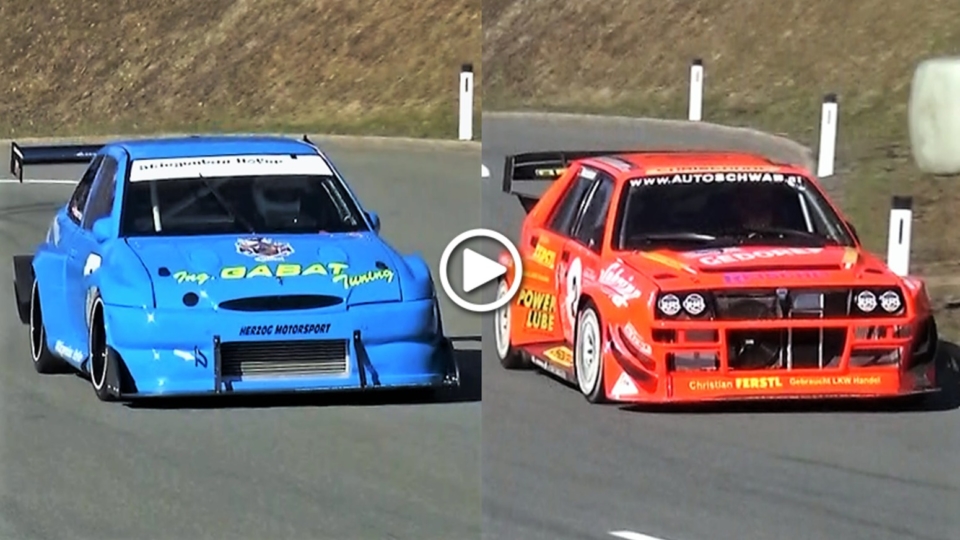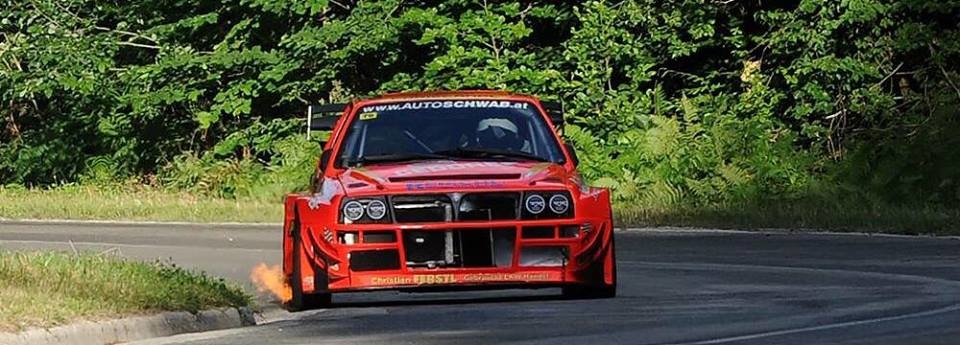Two colorful monstrosities with similar dimensions, four driven wheels, and similar outputs doing battle for hillclimb supremacy is a beautiful thing to watch. These ’90s rally icons, far from becoming old relics, still compete at the sharp end of the pack thanks to a slew of modifications, years of refinement, and the driving experience that their owners bring to the table. In the red corner, sexagenarian Felix Pailer and his Italian Lancia are likely the crowd favorite.
His bulldoggish Lancia Delta Integrale boasts some of the more muscular bodywork seen with this style of car, and the screaming engine complements that tough exterior. The 2.1-liter HB motor makes 650 horsepower and 590 lb-ft of torque, and that surge of power is only accessible through a narrow powerband. Thankfully, it’s geared appropriately, uses a racy carbon clutch, and only has to push around 2,300 pounds—so it still manages to hit sixty in 2.7-3.0 seconds depending on the level of grip. Truly, this is a modern iteration of the cars from the Group B era.
Its short wheelbase and wide track make it quite agile, and with four driven wheels, it has no problem rocketing out of the corner exit without wheelspin. It also shows impressive stability at speed. Simply put, it has the right combination to excel in these hairpin-laden courses, and doesn’t seem to relent on any of the straights connecting these point-and-squirt corners.
In the blue corner is Werner Hofer’s Ford Escort RS Cosworth: another car which rose to prominence in WRC, and has become the kind of mainstay these hillclimbing events rely on. Light, agile, and immensely powerful, this Ford boasts similar specs in terms of peak output, but differs in a few critical ways. The engine is bored to a healthy 2.3-liters, and uses a set of choice KW shocks to give it visibly better compliance. This suspension, in conjunction with its extensive aerodynamic package, make it a reassuring machine when threading the needle between guardrails at serious speed.
Unfortunately, it’s a tad porkier than the Lancia—weighing in at 2,500 pounds—but it seems to have a little more urgency at the corner exit, where the extra displacement allows it to accelerate a little sooner than its Italian rival. Additionally, that straightline speed is improved by a quick-shifting Quaife sequential gearbox. With so many short straights dotting the course, that minor advantage might be the difference which makes the difference.

With similar power outputs, layouts, and weight, the difference between these two comes down to a few subtle engine characteristics.
It’s difficult to determine where the two differ exactly, but considering how most of the Kitzeck Hillclimb is uphill, the Cosworth’s engine give it a substantial advantage over the Integrale. At the end of the event, the blue Ford netted a time 0.7 seconds faster than the Lancia’s.
With these two leading the E1-4WD class and dicing within such a tight margin, it shows how well these two ’90s icons have aged. Plus, with both these cars tuned by the same Andreas Gabat, it’s fantastic PR for the famed builder.






















